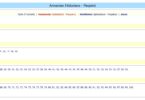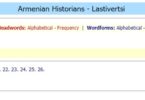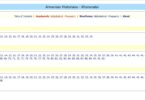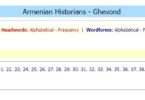Tigran Sahakyan
Lawyer and State Expert
Why is it called the Armenian Highlands?
HISTORICO-GEOGRAPHICAL FACTS OF THE IMPLICATION OF ETHNOTOPONYMS OF THE ARMENIAN PLATEAU (ARMENIAN MOUNTAINS, ARMENIAN HIGHLANDS, ARMENIAN MOUNTAINOUS ISLAND, ARMENIAN UPLAND)
2020
The Armenian Plateau, sometimes called Armenian Highlands, a physical geographical area of our planet (Pateauarmenien, Das armenische Hochland-Bergland, Армянское нагорье)[1] extends between 37° and 41°30´ northern latitudes and between 38° and 47°30´ eastern longitudes (Greenwich). It is located on the north of Asia Anterior, between the Iranian and Micro-Asiatic (Anatolian) Plateaus.
The Armenian Plateau, the cradle of the Armenian people, is the main territory of the indigenous Armenian language and its use, Armenian spiritual and tangible culture, and the development of the history of the Armenian people. Its average altitude is 1500-1800 m (4922-5910 ft). The contour lines of the Armenian Plateau show the elevation difference between the Armenian Plateau and surrounding Micro-Asiatic and Iranian Plateaus, which is more than 500 m (1641 ft).[2]
The peaks of mountains, rising more than 3000 m (9843 ft), dominate the Armenian Plateau. The Armenian Plateau’s absolute elevation varies from 400 (1313 ft) to 5156 m (16916 ft) (Greater Masis) above sea level. In comparison with Micro-Asiatic (Anatolian) and Iranian Plateaus, it occupies a mountainous terrain with an elevation that exceeds 500 m (1641 ft). That was the reason geographers called it ‘mountainous island.’[3]
As a toponym of the Armenian cradle, the Armenian Plateau was first adopted by Wilhelm Hermann Abich (1806-1886) of German origin, of course, and Academician at the Russian Imperial Academy of Sciences, who published his work Uber die geologische natur des Armenische Hoshlandes (On the Geological Nature of the Armenian Highlands) in German in the University of Dorpat in 1843. Thus, this toponym became standard in all encyclopedias and European literature as an official and scientific onomastic term.
Abich, a geologist, scientist, and traveler, visited Armenia with the financial support of Russian Emperor Nikolas I. He climbed the top of Mount Ararat on the morning of July 27, 1845 (he was the third scientist in this regard, after Friedrich Parrot and Xač´atur Abovyan (1829), and Orientalist Kozma Spasski Avtonomov (1834)).
While Abich enjoyed popularity throughout the world and was an author of more than 200 scientific works, he published his famous study, Geologie des Armenishen Hochlandes (Geology of the Armenian Highlands) in 1882, referring to the Plateau as Armenian in honor of its native Armenian people. Thanks to Abich, prominent scientists and geographers, Alexandr Vreykov, Franz Levinson Lessing, Alexander Leicester, Anatoly Raingarden, Nikolas Koronovsky, Semyon Matveev, Evgenia Milanovski, and the scientific world of the subsequent period widely used the toponym Armenian Plateau as an individual mountain cartographical unit.
The Armenian Plateau borders upon the Arsian-Tṙełk´ (Trialeti), a Mountain System, to the north and stretches along the Armenian Taurus in the south. The mountain range of the Lesser Caucasus and Aytsptkunkՙ (the Parachoathras Mountains of the Armenian Chain or Haykakan Par) pass through a volcanic plateau lying between the Trialeti mountains and the Armenian Taurus. These four mountains systems split the Armenian Plateau into three parts:
1․ Northern or Gugark´ Land or Highland, between the Mountains Arsian Tṙełk´ (Trialeti) and the Lesser Caucasus
2․ Central Highland, between the mountainous massif of the Lesser Caucasus and Aytsptkunk´
3․ Southern Highland, between the Aytsptkunk´mountain range and the Armenian Taurus[4]
The highest point of this Plateau, Mets Masis or Great Ararat with an elevation of 5156 m (16916 ft), is located in the center of the Armenian Highlands. Mount Sabala (Sebelea), with an elevation of 4821 m (15817 ft) is located on the furthest east of the Armenian Highlands. Of the mountain ranges in these highlands, the famous mountain is Sip´an (4434 m or 14548 ft) located in the north of Lake Van; on the west of Lake Van is Nimrod (3050m or 10006 ft ); Aragats (4090m or 13419 ft), and Kaputčyuł are situated in the mountainous massif of Syunik´ (3904 m or 12808 ft); Mets Abul or Great Abul begins from the Javaxkՙ Land (3301m or 10830 ft); Mṙav (3124 m or 10249 ft ) and K´irs (2725 m or 8940 ft)[5] lie in the Arts´ax Land.
The Armenian Plateau is nourished by the Euphrates, Tigris, Araxes (Erasx), Kura (Cyprus), and Čorox, the main rivers of Asia Anterior․ There are also numerous lakes, among which are Sevan, Van, Urmia (Kaputan), Pՙarvana, Tsՙel.[6] In addition to the ethnotoponyms (see supra), the Sumerians, the Antique World, many geographers, historians, and travelers of the Middle Ages referred to the Armenian cradle as Armenian Mountain Range, Armenian Plateau, mountainous island, Armenian mountains. Thus, the Sumerian map, Mother Land and Universe (or Places in the Ancient Near East), compiled in the third millennium BC, marks the present-day mountainous Armenian Highlands as a nourishment place of the Euphrates and the Tigris.[7] Apart from the epithets Land of God, Land of Immortals, Land of Holy Laws, Land of Sacred Rituals, Aratta, as the first Armenian state union, was called ‘land of towering mountains’ in the Sumerian epic “Enmerkar and the Lord of Aratta” in the fifth and fourth centuries BC.[8]
The inscription of Hittite King Mursili II (1340-1320 BC), giving shreds of evidence of the invasion of Armenia by his great-grandfather Tudhaliya III (1400-1380 BC), reads: “The enemy- the foot soldiers and warriors of war wagons from the country Hayasa, had destroyed the City of Istitina by “high land,” and besieged the City of Kanuvara.”[9] Historically, the high land is an Erzinka region (Erzincan) in Western Armenia.[10]
In Genesis, for example, it is the mountains of Ararat that are described: “The water receded steadily from the earth. At the end of the hundred and fifty days, the water had gone down, and on the seventeenth day of the seventh month the ark came to rest on the mountains of Ararat.”[11] The Armenian statehood of the ninth and sixth centuries BC, in the valleys of Mount Ararat, has been known as “the land of Ararat” in 2 Kings (2 Kings 19: 36-37 NIV).[12]
According to the Bible, Mount Ararat, with an elevation of 5156 m (16916 ft) from the sea, located in the center of the Armenian Highlands, and its lowlands (Ararat Valey) are the cradle of the modern life of humanity and civilization, “By the twenty-seventh day of the second month the earth was completely dry. Then God said to Noah, “Come out of the ark, you and your wife and your sons and their wives. Bring out every kind of living creature that is with you—the birds, the animals, and all the creatures that move along the ground—so they can multiply on the earth and be fruitful and increase in number on it.” So Noah came out, together with his sons and his wife and his sons’ wives. All the animals and all the creatures that move along the ground and all the birds—everything that moves on land—came out of the ark, one kind after another.”[13]
The Behistun Inscription in three languages- Old Persian, Elamite, and Akkadian on a rock near the City of K´ermashen (Hamadan) in Iran, commissioned by Persian King Darius the Great (Vshtaspi) (522-486 BC) in the sixth century BC, mentions the name Armina-Arminia in Old Persian, whereas the Akkadian inscription refers to Armenia as Urashtu (Urartu).[14] Notably, Armenia is known as the land of Ararat[15] or the kingdom of Ararat by Jews in the Bible.[16]
Furthermore, the toponym Armenian also appeared in the Histories by Herodotus, the Father of the Greek historiography (484 BC- AD 425), who referred it to the mountains of the Land of Armina (Arminia)-Urashtu (Urartu)-Ararat (Kingdon of Ararat). He wrote: “Because the border between the Median power and the Lydian power was the Halys or Halis River [my italics], which streamed down from the mountains of Armenia ….”[17] The historiographer also provided the following important information in his account: “And the city, Babylon [my italics] is divided into two parts because the river that flows through it is the Euphrates. It flows from Armenia…”[18], “…in Armenia, which lies above Assyria….”,[19] “The border between Cilicia and Armenia is a navigable river called the Euphrates…the road enters Matiene from this Armenia….The Tigris River begins from Armenia ….”[20] The details (see supra) confirm that Herodotus had already used the geographical name Armenian mountains in the fifth century BC (AD, about 2600 years ago).
In his Anabasis, the Greek historian Xenophon (430-356 BC), who accompanied a large army of 10.000 Greek mercenaries, marching across the western Tigris to the upper course of Araxes, and northwards to Trabzon through Armenia in 401 BC, described an ethic picture of the Armenian rich villages. He wrote: “Here, most of the houses were surmounted with turrets, and provisions were plentiful. In the houses were goats, sheep, cattle, fowls, and their young; and all the animals were reared and took their fodder there in the houses. There were also wheat, barley, and beans, and barley wine in large bowls. Floating on the top of this drink were the barley-grains and in it were straws, some larger and others smaller, without joints. There they had all possible good things in the way of supplies—animals for sacrifice, grain, old wines with a fine bouquet, dried grapes, and beans of all sorts ….”[21]
The details in Anabasis show that Xenophon called the mountains of this geographical area by the topo-ethnonym of the native and primary population living there. An antique Greek historian, Diodorus of Sicily (90-23 BC) also implied the toponym Armenian Mountains, “Semiramis or Shamiram [my italics] quarried out a stone from the mountains of Armenia which was one hundred and thirty feet long and twenty-five feet wide and thick; and this she hauled by means of many multitudes of yokes of mules and oxen to the river and there loaded it on a raft, on which she brought it down the stream to Babylonia; she then set it up beside the most famous street, an astonishing sight to all who passed by.”[22]
Strabo, an eminent Greek geographer (63 BC- AD 20), gave a lavish account of different parts of Armenian mountains (modern Armenian Plateau) and local and administrative-political borders of the Greater Armenia state. Depicting the Asia continent and nations and countries of Asia Anterior in particular, he ranked the Armenian people and Armenia among the well-known races. He wrote: “But, since a few nations dwell within the borders of a giant mountain, some of them are less famous, some of them are undeniably known (such as Parthia, Media (Marastan), Armenia, some Cappadocians, Cilicians, Pisidians) ….”[23] Strabo unfolded those parts of the Armenian mountains, which demarcated the natural borders of the Greater Armenia state. Thus, he stated: “Some Greater Caucasus mountain ranges stretch to the south; they cover the middle part of Iberia, today’s Eastern Georgia [my italics], lying across Armenia and the Moschian Mountains, and also the Mountains Scydisis and Paryadres.”[24]
By that, Strabo characterized the Armenian Plateau’s natural north-eastern borders that mostly correspond to the Greater Armenia with its territories. He also pointed out the eastern borders of the Greater Armenia (respectively, the Armenian Plateau). He noted, “…The Caspian Sea is already flowing down to its confluences, passing across the Median and Armenian Mountains.”[25] Strabo showed the southern border of the Greater Armenia (i.e., the Armenian Plateau). He wrote: “… Here its height and breadth greatly increase, and its branches are more numerous. At all events, the most southerly part is the Taurus proper or the Armenian Taurus [emphasis mine], which separates Armenia from Mesopotamia.”[26]
Strabo also identified the borders demarcated between Greater Armenia (i.e., the Armenian Plateau) and Asia Minor (Anatolia): “Thence flow both rivers, I mean the Euphrates and the Tigris, which encircle Mesopotamia and closely approach each other in Babylonia and then empty into the Persian Sea. The Euphrates is not only the larger of the two rivers, but also, with its winding stream, traverses more country, having its sources in the northerly region of the Taurus, and flowing towards the west through Greater Armenia, as it is called, to Lesser Armenia, or Pՙokr Haykՙ [emphasis mine], having the latter on its right and Acilisene on the left. It then bends towards the south, and at its bend, joins the boundaries of Cappadocia.” He continued: “… and leaving these and the region of Commagene, which is Ełekyatsՙ Province of Upper Armenia [my italics] on the right, and Acilisene and Sophene or Tsopՙkՙ Province [my italics], in Greater Armenia on the left, it runs on to Syria and again makes another bend into Babylonia and the Persian Gulf ….[27]
Additionally, Strabo constituted the south-eastern borders of Greater Armenia (which barely differs from the Armenian Highlands). He wrote: “Araxes forms the boundary between Armenia and Atropatene (Atrapatakan)[28]…, finally, Media is bounded on the west with Atropates and Armenians only in part.…[29] Indeed, the Atropates have powerful neighbors in the Armenians and the Parthians.”[30] Strabo simply outlined the southern borders of Greater Armenia. He recorded: “On the other side of the Euphrates, in the neighborhood of Minor Armenia to the north, large mountains and many mountain ranges stretch along with the Antitaurus. The Paryadres is one of those mountain ranges, and the other one is Moschian; the third has various names. Those mountains extend across entire Armenia, Iberia, and Caucasian Albania….”[31]
It is known that the territory of the Armenian Plateau is inconsiderably larger than 300.000 sq. km[32] and corresponds almost to the territory of the most potent state, Greater Armenia that had reached 312.795-285.195 sq. km,[33] expanding its borders on the same territory in the 2nd BC – AD 387; thus, Greater Armenia and the Armenian Plateau are identified. It is worth noting that the Armenian-Roman treaties concluded at Artašat (66 BC) and Rhandeia (AD 65), and the treaty concluded between the Roman Empire and the Parthian Empire in AD 37 recognized and ratified the territorial integrity of Greater Armenia that covers the Armenian Plateau.[34]
Strabo also gives an overall picture of the borders of Greater Armenia (Armenian Plateau) based on the geographical description (see supra). He noted: “The southern parts of Armenia lie in front of the Taurus, which separates Armenia from the whole of the country situated between the Euphrates and the Tigris, and which is called Mesopotamia. The eastern parts are contiguous to the Greater Media and to Atropatene. To the north is the range of the mountains of Parachoathras lying above the Caspian Sea, the Albanians, Iberians, and the Caucasus. The Caucasus encircles these nations, and approaches close to the Armenians, the Moschic and Colchic mountains, and extends as far as the country of the people called Tibareni. On the west are these nations and the mountains Paryadres and Scydises, extending to the Lesser Armenia, and the country on the side of the Euphrates, which divides Armenia from Cappadocia and Commagene.”[35]
Moreover, Strabo keeps retelling with close attention to the ancient lands near Armenia: “Artašes’s successor is Tigran, who ruled over Armenia in the full sense of the word. This country borders upon Media, Caucasian Albania, and Iberia, extending to Colcida and Cappadocia upon the Euxine Pontus. The descendant of Zareh was Artan the Sophenian, who had the southern parts of Armenia, which verge rather to the west.”[36]
Strabo, finally, marked out the political borders and administrative structure of Greater Armenia, which primarily lie in the territory of the Armenian Highlands. He wrote: “According to historians, Armenia, which was formerly a small country, was enlarged by Artaxias and Zariadris, who had been generals of Antiochus the Great, and at last, after his overthrow, when they became kings, (the former of Sophene, Acisene, (Amphissene?) Odomantis, and some other places, the latter of the country about Artaxata,) they simultaneously aggrandized themselves, by taking away portions of the territory of the surrounding nations: from the Medes they took the Caspiana, Phaunitis, and Basoropeda; from the Iberians, the country at the foot of the Paryadres, the Chorzene, and Gogarene, which is on the other side of the Cyrus; from the Chalybes, and the Mosynaeci, Carenitis and Xerxene, which border upon the Lesser Armenia or are even parts of it; from the Cataones, Acilisene, and the country about the Anti-Taurus; from the Syrians, Taronitis; hence they all speak the same language.”[37]
The topographical localization of those regions in Greater Armenia (Strabo, op.cit.) is the following: the Caspiane or Kaspiane is Paytkaran,[38]Phaunitis is a Paṙios Province of Artsՙax;[39] the lands at the foot of the Paryadres Mountains are the Eastern-Pontic mountains on the east of the Pontus mountain system; on the south of the Black Sea, they are stretched to the south in the north-eastern direction, from Šapin-Garahisar to the mouth of Čorox. The Eastern-Pontic mountains are also called ‘the Parxar Mountains.’ These lands are called ‘Xałtik´’ (Chaldian or Eastern Pontic), which were then called Laz (or Čani) by Georgians by the Laz people dwelling there.[40] Chorzene is Kłarǰk´.[41] Gogarene is Gugark´,[42] Carenitis is the field of Karni (Erzrum) of Upper Armenia,[43] Xerxene, or Derxene is a Derǰan Province of Upper Armenia,[44] Acilisie is an Ekełyatsՙ Province of Upper Armenia.[45] The lands lying around the Antitaurus continue the mountain chain to the west of the Antitaurus Mountains,[46] and the Taronitis are Upper, Middle, and Inner Kodrik´ Provinces of Greater Armenia. [47]
Similarly, Roman historian Gaius Plinius Secundus (AD 23/24-79) gave a detailed description of the borders of the Greater Armenia state (see Pliny, Nat. 6.9. (9).1). He wrote. “Greater Armenia, beginning at the mountains known as the Paryadres, is separated, as we have already known, from Cappadocia by the river Euphrates, and, where that river turns off in its course, from Mesopotamia, by the no less famous river Tigris. It thus extends its frontier to Adiabene, Greater Armenia [emphasis mine], separated from that province by a chain of mountains; in length, the province reaches Minor Armenia on the left side, from which it is separated by the River Absarus, which flows into the Euxine, and by the mountains known as the Paryadres, in which the Absarus takes its rise. According to Affodius, the length of the entire territory of Greater Armenia is 5.000.000 steps. Emperor Cladius calculates its length from Daskus (or Dashkus) to the Caspian Sea by 1.300,000 steps, and the width [by] its half, from Tigranakert to Iberia, Kharthli [emphasis mine].”[48]
The subtly inconsistent facts (see supra) of the length and width of the territory of the Greater Armenian state, of course, refer to the length and width of the Armenian Plateau as well. Those territories were inhabited by 3.5 000.000 Armenian-speaking population[49] in the first century, which made up 2.3% of 150.000.000 population of the world in that period.[50]
Roman historiographer Flavius Josephus (Jew by origin) (b. about 30 BC) treated the mountains that covered the territories of the Greater Armenia state of the first century (renamed Armenian Highlands) as ‘Armenian.’ He wrote: “Berossus*, Chaldean by origin…like Moses, told about the arc, in which Nukus [?] or Noah [my italics], the forefather of our nation, was saved when the ark was pulled and rested on the heights of the Armenian mountains.…”[51]
Flavius viewed the Euphrates as a border between Greater Armenia and Cappadocia. He wrote: “And Emperor…the twelfth regiment… sent to the Euphrates, on the border of Armenia and Cappadocia.”[52] The Euphrates River is a border not only between Greater Armenia and Cappadocia but also Armenian Plateau and Asia Minor peninsula (renamed Anatolia). Flavius also mentioned the highest peak of the Armenian Plateau, Masis. He wrote: “…There is a giant mountain, called Baris, which is Masis [emphasis mine], where, according to the history, many took shelter and were saved during the flood, and one [of them], having been taken to the arc, descended to the top….”[53]
In his Roman History, the Roman historian Dio Cassius (c.155-c.235) supplied details about the Armenian-Roman treaty concluded at the heart of the Armenian Plateau, Artašat in 66 BC. He recorded: “Pompey, hearing them, returned the head, Tigran II [emphasis mine] all his districts, i.e., Greater Armenia [emphasis mine], but he took from him the lands he had invaded, among which are the parts of Cappadocia and Assyria, as well as Phoenicia.”[54] Another Roman historian Plutarch (43-AD 123), attests to the same reality.[55]
According to Dio Cassius and Plutarch, Rome left the Greater Armenia state to Tigran II that had natural borders of the Armenian Plateau. En passant, the History of Rome (1971) published in Moscow clarifies the results of the Armenian-Roman treaty concluded at Artašat in 66 BC as follows: “…Armenia was confined within its indigenous borders…”[56], which means within territories of the Greater Armenia state founded in the Armenian Plateau. Besides, in work under discussion, the northern part of the Greater Armenia of the first century BC is viewed as a territory lying between the Euphrates and the Kura. It states: “Pompey set up his army in the winter settlements on the north of Armenia, between the Euphrates and the Kura .…”[57]
As a result of the division of the Greater Armenia state between Rome and Sassanid Persia in 387, the one fifths of the Armenian Plateau passed to Rome (renamed Byzantium), and the fourth fifths went under the political control of Sassanid Persia. This situation endured up to the second partition of Armenia between the powers (see supra) in 591. In this period, the portion of Armenia under the control of Persia (Eastern Armenia or Persiarmenia) maintained the marzpan authority [viceroy rule]. In the meantime, in 535-536, Byzantine Emperor Justinian I re-established the administration of the part of Armenia inferior to Byzantium and split it into four districts or provinces- Armenia I or Prima, Armenia II, Armenia III, and Armenia IV.[58] However, it did not prevent its local owners, Armenians from preserving their ethnic dominance in the Armenian Plateau.” Thus, Byzantine historiographer Procopius of Caesarea, who was appointed a duke of Mesopotamia in 527, wrote: “I found it convenient to begin with Armenians, who have settled [in the regions extending] from Amida to other Theodosiopolis or Karin [my italics], in front of Persians.”[59]
He wrote: “…As for the other Haykՙ (Armenia), which is located on the other side of the Euphrates River, and stretches along the City of Amida, five Armenian satraps are ruling there, whose power was hereditary and indefinite ….”[60]
He treated Tsopՙkՙ as Armenia. He stated: “… Armenia called Sophene or Tsopՙkՙ [my italics].…”[61] According to Procopius of Caesarea, the territory that extends from the Euphrates to the east, is Greater Armenia. He wrote: “This is what Justinian did in Armenia located on the left eastern bank of the Euphrates River [my italics]. I will tell you what he did in Greater Armenia…There he established all the armed forces and the Commander-in-Chief of Armenians. And he made the Armenians more powerful so that they would never be frightened from Persian attacks.”[62]
Procopius of Caesarea gives valuable information: “The Čani (Laz) people dwell very far away from the coast of the Black Sea [emphasis mine], in the neighborhood of Armenians, in the Middle World. Here, quite impassable and steep mountains soar high …On the right side of this place near Trabzon [emphasis mine], the Laz mountains rise, on the other side of which the Armenians, subject to Romans, live.”[63] The places of Armenia (also of the Armenian Plateau) represented in the Procopius’s historical source occupy the north-western parts.
Arab historian Ibn al-Athir (1160-1233), like many other historiographers and geographers, mentioned Armenia, Georgia, Caucasian Albania, Near Caspian provinces and Derbend by a common toponym Arminia (Hayastan) in 705-885,[64] and the mountains situated here- mountains of Hayastan (Arminia),”[65] although in this text the author meant the Caucasus Mountains in the mountain system of Historical Armenia. Nevertheless, in his al-Kamir fi at-Tarikh (The Complete History), he noted: “And Babak went to the Armenian Mountains to hide.”[66]
The Georgian sources hold remarkable information about the Armenianness of the highlands under discussion. Thus, according to the compendium, Conversion of Kartly by a ninth-century Georgian anonymous historian, the virgin Nune, known as St. Nino by Georgians, went to Kharthli from Armenia and disseminated Christianity, and was then martyred. She said: “…(In Jerusalem) the Patriarch gave my mother to the poor and sick women to serve, and I was serving an old Armenian, Niapՙora Dvinetsՙi for about two years… This Niapՙora, by the way, told me: “The northern land (where Christ’s gown is buried) is located in the Armenian Highlands ….”[67]
In his Chronicle of Georgian Kings, Pre-Armenians, and Dynasties, the eleventh-century chronicler Leontius of Ruisi (Leontis Miraveli) noted: “…Torgom (or Thargamos) was the father of all these nations- Armenians (Somkhetian people) and Georgians (Kartlos), Ranakos and Movakos, Egertos (Megrelians) and Caucasian [race]. This Torgom (or Thargamos) would be a son of Tarshish, son of Havana, son of Jabeth, son of Noah…And this Torgom (or Thargamos) was a fearless man. And after the division of language, when Nimrod built a tower in Babylon, and the languages were scattered all around the world, this Torgom (or Thargamos) came with all his people and settled between two mountains, Ararat and Masis, which were unreachable to people… But among Torgom’s sons, the eight [tribes] became famous, (as) valiant and well-known giants, whose names are; the first was called Hayk (Haos), the second-Kartlos, the third-Bardos, the fourth-Movakos, the fifth- Lekos (Lak), the sixth-Heros (Hernas), the seventh-Caucas (Kovkases), the eighth-Egros (Egers)…But the land of Ararat and Masis could no longer settle them…Torgom (or Thagarmos) divided his country and people among these eight giants, the half of his people and the best part of his country gave to Hayk (Haos) and gave the other seven their share by their choice…
Hayk (Haos) inherited the country belonging to his father, Torgom (or Thargamos), and ruled the (bordering) lands on the north, as we have already stated; the Uret´ mountains [sic] on the south, the Kurgan Sea in the east, the Pontus Sea in the west. And the governor and prince of these seven giants was Haik (Haos), and thus, all of them were subject to Haos, and all of them had one [common] language, Armenian (Somkhetian)…”[68] The Haik (Haos) of the Georgian myth (see supra), is a forefather and bearer of the name of the Armenian people. The Mount Uret´ is located in the Armenian Taurus; the Kurgan Sea is the Caspian Sea, and the Pontus Sea is the Black Sea, and the Armenian Highlands- the Armenian native land lies between them.
The ninth-century anonymous historian, expounding upon the historical events of the tenth and eleventh centuries in a Georgian codex, noted: “…(King Geworg, son of Georgian Bagrat), gave Samshvilde to Hovhan (Ivane)[69]…but Hovhan (Ivane) could not stay inside the fortress and left for Armenian (Somkhetian) mountains…”[70]
There are significant pieces of evidence of the Armenian Plateau in European sources. For instance, the German poem “Song of Anon,” written at the beginning of the twelfth century, devoted to the bishop of Cologne, Anon, indicates that the fatherland of the Bavarians is Armenia, and the Bavarians came from “Armenia, a mountain country, where Noah left his savior arc…. Arc, which is still in its place, on the high summit of Ararat….”[71] Another German poem of the twelfth century, “The Emperor’s Chronicle” (on the campaigns led by the Roman Emperor Julius Caesar in the first century BC), points out:
…The Bavarian tribe
Descended from Armenia…
Where Noah has left the arc, his savior
There are still the traces of the arc
On the top of the mountain called Ararat….[72]
The Anglo-Saxon Chronicle of the eleventh century states that the Britos came from Armenia,[73] and Richard Folwer, who studied this chronicle in the eighteenth century, fairly used the phrase “Armenian Britos.”[74]
Many hypotheses and deductions in this paper on the Armenian Plateau, and Armenia and Armenian people can be found in many European sources and scientific studies. Moreover, the ethnotoponym Armenian for these mountains that was a subject presented for consideration by Abich, and hundreds of European scientists, political and state figures, has always been and should be historically and geographically grounded and fair, since the Armenians as native and main population of this region of the world have developed and will develop its rich cultural and state-political life for millennia at the Armenian Plateau.
[1] Г. В Абих, Геология Армянского нагорья, Западная часть (Записки Кавказского отделения императорского русского географического общества, henceforth, ЗКОИРГО), т. XXI, 1899.
[2] а) Г. В Абих, Геология Армянского нагорья, Восточное часть (ЗКОИРГО), т. XXIII, 1902.
б) Атлас сельского хозяйства Армянской ССР (Главное управление геодезии и картографии при совете министров СССР, Москва – Ереван, 1984, c. 10-11, 171.
[3] К. Риттер, Землеведение Азии, СПБ, 1856, т․ 1, с․ 83․
[4] С. П. Бальян, Структурная геоморфология Армянского нагорья и окаймляющих областей, Ереван, 1969, стр. 17-19․
[5] Атлас сельского хозяйства Армянской ССР, c. 10-11․
[6] Ibid.
[7] Rouben Galč´yan, Armenia in the World Cartography (Yerevan, 2005), Anžela Teryan, Древние письменные источники народов Европы о своей прародине-Армении и армянах [Ancient Written Sources of the People of Europe about Their Homeland, Armenia and Armenians] (Yerevan, 2016), 5-6; 105․
[8] Teryan, Ancient Written Sources, 6; Samuel Kramer, The Sumerians: Their History, Culture and Character (Chicago: University of Chicago Press, 1963), I. Kaneva, “Enmerkar and the Lord of Aratta,” Journal of Ancient History, no. 4 (1964): 208; Artak Movsisyan, The Ancient History in Armenia, Aratta [in Armenian] (Yerevan, 1992), 10-12.
[9] Valeri Xač´atryan, transl., Collection of the History of Armenian People [in Armenian], vol. 1, (Yerevan, 1981), 7; Step´an Melik´-Bašxyan, Source Study of the History of Armenia [in Armenian] (Yerevan, 1996), 14.
[10] Bašxyan, Source Study, 14.
[11] Gen. 8:3-4; 14 -19.
[12] Jer. 51:27; 28; Ȓafayel Išxanyan, Issues of the Origin of the Armenian People and Ancient History [in Armenian] (Yerevan: “Hayastan” Press, 1988), 65.
[13] Gen. 8:14-19.
[14] Mik´ayel Nalbandyan, transl., The Behistun Inscription of Darius Vshtaspi [in Armenian] (Yerevan, 1964), Bašxyan, Source Study, 23-27; Išxanyan, Issues of the Origin, 68-70.
[15] Jer. 51:27 -28; 2Kings 19:36-37.
[16] Jer.51:27.
[17] Herodotus, The Nine Books of the History of Herodotus (henceforth, Histories) [in Armenian], transl. Simon Krkyašaryan (Yerevan: NAS Press, 1986), 1. 72. 32.
[18] Herodotus, His. 1. 180. 74.
[19] Herodotus, His. 1. 194. 80.
[20] Herodotus, His. 5. 52. 307.
[21] Xenophon, Anabasis, trans. Simon Krkyašaryan (Yerevan, 1970), 4.1-9. 3; 4. 25. 97.
[22] Didodorus of Sicily, Historical Library, trans. Simon Krkyašaryan, (Yerevan, 1985), page 16, 2. 6.11 Bašxyan, Source Study, 34.
[23] Страбон, География (пер. Г. С. Утченко), изд. “Наука”, Ленинград, 1964г., кн. ХI, ч. I, п. 4 (с.466).
[24] Страбон, География, XI, ч. II, п․ 15 (c․ 472)․
[25] Страбон, География, XI, ч. VII, п․ 1 (c․ 481)․
[26] Страбон, География, XI, ч. XII, п․ 2 (c․ 492)․
[27] Страбон, География, XI, ч. XII, п․ 3 (c․ 492)․
[28] Страбон, География, XI, ч. XIII, п․ 3 (c․ 494)․
[29] Страбон, География, XI, ч. XIII, п․ 6 (c․ 494)․
[30] Страбон, География, XI, ч. XIII, п․ 2 (c․ 493)․
[31] Страбон, География, XI, ч. XII, п․ 4 (c․ 492)․
[32] Tՙadeos Hakobyan, Contour Lines of the Armenian Historical Geography [in Armenian] (Yerevan, 1960), 7; Grigor Avagyan, Armenia and Armenians in the World [in Armenian] (Yerevan, 1992), 8.
[33] Suren Yeremyan, Armenia According to the World Atlas [in Armenian] (Yerevan: NAS Press, 1963), 66-67; 118.
[34] Yeremyan, Armenia, 66-67; 118; Plutarch, Parallel Lives, trans. Simon Krkyašaryan (Yerevan, 2001), 3. 265; Gagik Sargsyan, ed., Simon Krkyašaryan, transl., “Dio Cassius. Roman History” in Old Greek Sources; Josephus Flavius and Dio Cassius [in Armenian], vol. 9 (Yerevan: NAS Press, 1976); 36. 52. 1-4; 53.1-5; 60.23.1-6.
[35] Страбон, География, XI, ч. XIV, п․ 1 (c. 496).
[36] Страбон, География, XI, ч. XIV, п. 15 (c. 500).
[37] Страбон, География, XI, ч. XIV, п․ 5 (c. 498).
[38] T´adeos Hakobyan, Dictionary of Toponymy of Armenia and Adjacent Territories [in Armenian] (henceforth, DTAAT) (Yerevan: YSU Press, 1988), 2.961, s.v. “Paytkaran.”
[39] Hakobyan, DTAAT 5.241; 239, s.vv. “Phaunitis”, “Paṙios.”
[40] Hakobyan, DTAAT 3. 314; 2. 632-633, s.vv. “Laz,” “Čani.“
[41] Hakob Manandyan, Studies, vol.1 (Yerevan, 1977), 121.
[42] Anania Širakats´i, Mirror of the World [in Armenian] (Yerevan: “Hayastan” Press, 1979), 29; Yeremyan, Armenia, 118.
[43] Hakobyan, DTAAT 3.42-45, s.v. “Carenitis.“
[44] Hakobyan, DTAAT 2.92; 94, s.vv. “Derxene,” “Derǰan.”
[45] Hakobyan, DTAAT 1.134, s.v. “Acilisie;” Širakats´i, Mirror, 291.
[46] Hakobyan, DTAAT 1.286, s.v. “Antitauros.”
[47] Hakobyan, DTAAT 5.25; 109, s.vv. “Taronitis,” “Kodrik´”; Širakats´i, Mirror, 294.
[48] See also Plinii Secundi C., Natutalis historiae, 1-10, Cambridge, Mass-London, 1950-1962 (loeb classical library).
[49] Strabo, Anab. 9; 14. 5. 498.
[50] Tsatur Ałayan, History of the Armenian People [in Armenian] (Yerevan: NAS Press, 1971), 842.
*Berossus ( 330-250 BC) was a priest of the temple of Bel in Babylon.
[51] Flavius Josephus, Against Apion (Book I . Chapter 130-131. ), see also Flavius Josephus and Dio Cassius, op.cit., 28.
[52] Ibid., 46.
[53] Ibid., 55.
[54] Ibid., 67.
[55] Plutarch, Parallel Lives 33. 265; История Древнего Рима (henceforth, ИДР), изд. “Вышая школа”, Москва, 1971, под ред. А. Г. Бокщанина и В. И. Кузищина, стр. 488 (Greater Armenia is not involved in the list of the provinces of the Roman Empire, whereas Cilicia, Syria and Phoenicia seized by Pompeos fromTigran II are the regions of the Roman Empire).
[56] ИДР, c. 221.
[57] Ibid.
[58] Hakobyan, Contour Lines, 101-114.
[59] Gagik Sargsyan, ed., Hrač´ Bart´ikyan, transl., “Procopius of Caesaria, History of the Wars” in Foreign Sources about Armenia, vol. 5; Byzantine Sources, vol. 1 [in Armenian] (Yerevan: NAS Press, 1967), 1.189.
[60] Ibid., 190.
[61] Ibid., 193.
[62] Ibid., 196-197.
[63] Ibid., 242-243.
[64] Hovhannes Melk´onyan, ed., Aram Ter-Łewondyan, transl., “Ibn al-Ahir. The Complete History” in Foreign Sources about Armenia and Armenians, vol. 11; Arabic Sources, vol. 2 [in Armenian] (Yerevan: NAS Press, 1981), 39-42 (see the paper dedicated to the toponym Hayastan on this page).
[65] Ibid., 67.
[66] Ibid., 142.
[67] Professor, Doctor Lewon Melik´set´-Bek, Georgian Sources about Armenia and Armenians [in Armenian], vol.1 (Yerevan, 1934), 22.
[68] Ibid., 143-148.
[69] Hovhan, sometimes called Ivane, is an Armenian Commander-in-Chief, Ivane Zak´aryan. He was a common Commander-in-Chief of Armenian and Georgian troops.
[70] Ibid., 208.
[71] Teryan, Ancient Written Sources, 35-36; Das Annolied, Mittelbochdeutsch Neuhochdeutsch, Reclam, 2006, 20.
[72] Teryan, Ancient Sources, 37; Hans F. Massman, Der Keiser und Kuige buoch oder die sogenannte Kaiserchronik, Guedinburg und Leipzig, 1849. S. 25-28. Hans F. Nöhbauer, “ Die Bajuwaren”, Weltbild Verlag, Augsburg, 1990, S. 15.
[73] Teryan, Ancient Sources, 69; Anglo-Saxon Chronicle 1. AD 1- 748.
[74] Teryan, Ancient Sources, 70; Eduard Danielyan, Progressive British Figures‘ Appreciation of Armenia’s Civilizational Significance. Versus the Falsified “Ancient Turkey” Exhibit in the British Museum [in Armenia] (Yerevan, 2013), 36-46; 109.







